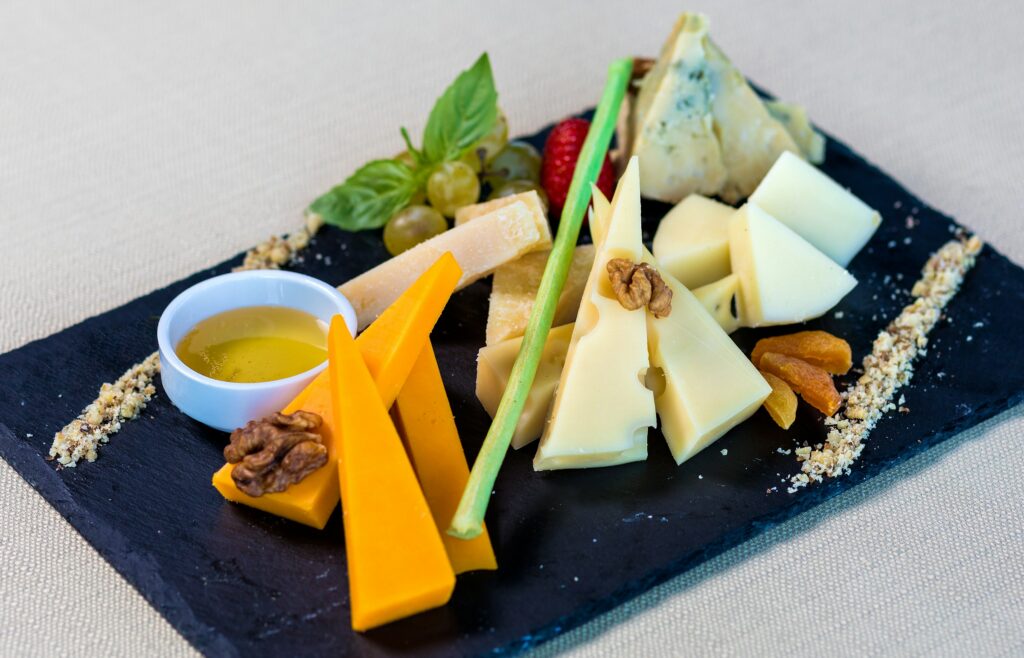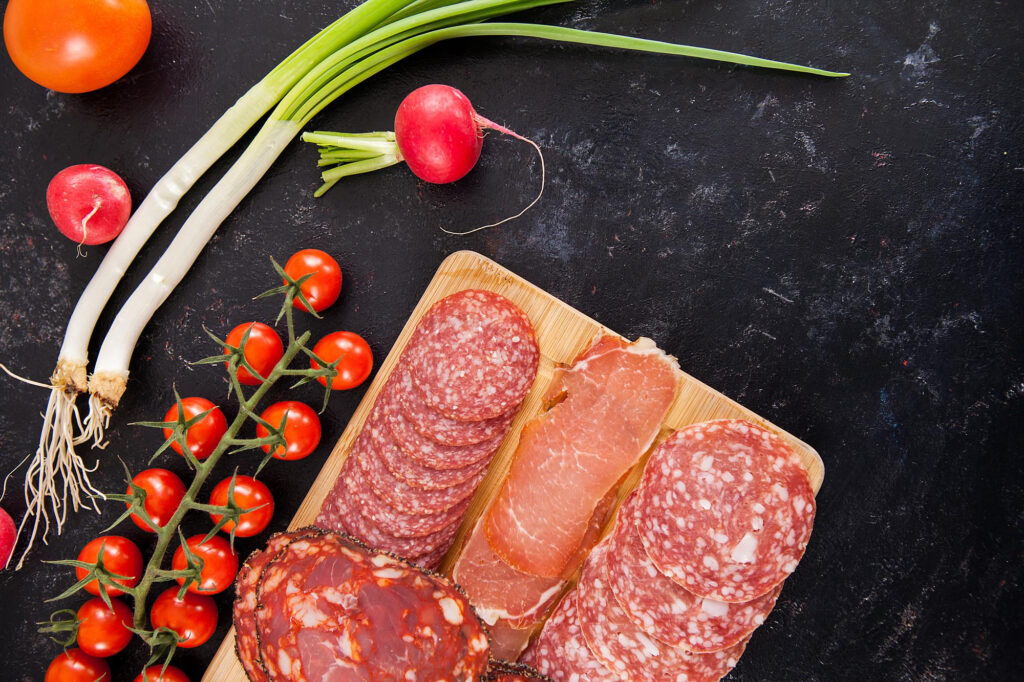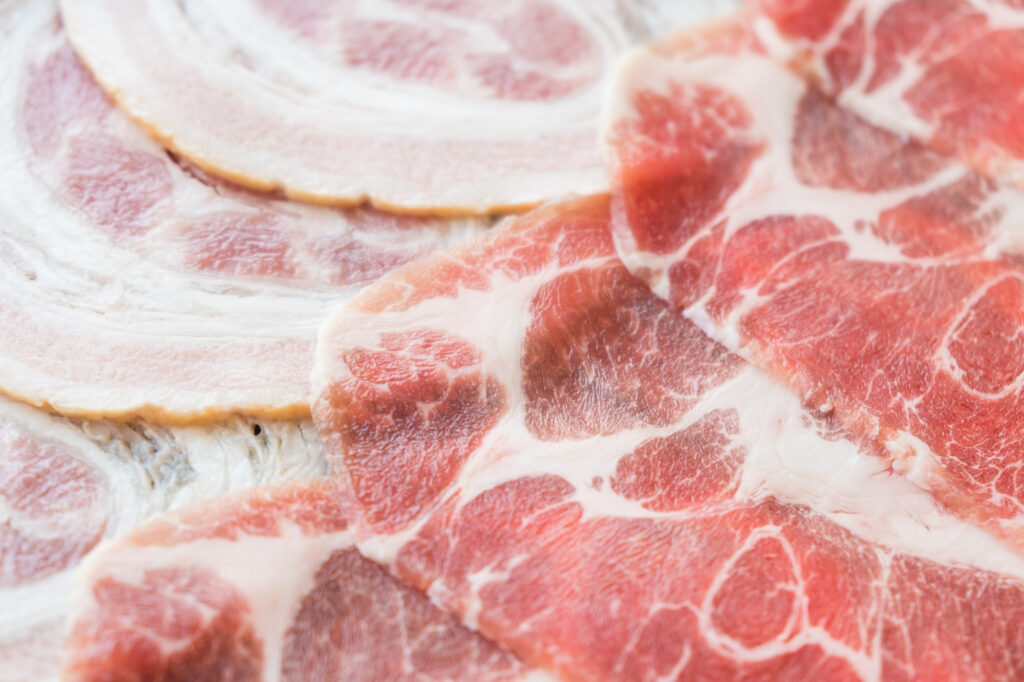Are you a digital nomad, traveler, or expat in search of the ultimate culinary delight in Buenos Aires? Look no further!
The bustling streets of Argentina’s capital are not just about tango and football; they’re a paradise for cold cut connoisseurs.
From the savory depths of jamón crudo to the rich, creamy textures of artisan cheeses, Buenos Aires offers a smorgasbord of flavors that can transform any meal into a festive occasion.
Dive into our guide on ‘The 10 Best Cold Cuts to Enjoy in Buenos Aires,’ brought to you by ExpatPathways, and discover the mouth-watering world of Argentine charcuterie that awaits your taste buds.
1) Cured Ham
Jamón crudo, a staple in Buenos Aires’ appetizer platters, is highly valued for its unique salty and smoky flavor, making it an excellent pairing with other cold cuts and cheeses.
This delicacy, often featured in salads, sandwiches, and alongside drinks like vermouth and beer, is considered a “jewel” among cold cuts by locals. Its production involves the air drying and salting of the pig’s hind legs, resulting in a food item that’s naturally intense and delicate in flavor, smooth in texture, and beneficial for health due to its rich nutrient content.
Whether made from white or Iberian pig breeds, jamón crudo’s distinctive taste and juicy texture make it a versatile component in various culinary creations, cementing its status as a gourmet cold cut in Argentina.
2) Cheese
No Argentine ‘picada‘ (appetizer platter) would be complete without cheese, an essential companion to the country’s array of cold cuts. The Argentine market is replete with a diverse selection of cheeses, ranging from hard, semi-hard, soft, to creamy types, reflecting the expanding variety available to locals over the years.
Cheeses in Argentina are categorized by their moisture, fat content, rind, coagulation process, and aging, as well as by the type of milk used, including cow, sheep, goat, and buffalo.

Notably, many of the popular cheeses consumed locally are of European origin, adapted to suit the Argentine palate and regulations, alongside native cheeses produced in regions such as Tafí, Goya, Chubut, and Tandil. Among them, Queso Mar del Plata, Gruyère, Blue Cheese, Brie, and others offer a delightful taste experience, integral to Argentina’s culinary tradition.
Types of Argentine Cheeses
- Mar del Plata or Holland Cheese: A semi-hard, semi-fat cheese known for its unique name derived from the coastal city of Mar del Plata. Characterized by its light yellowish paste with well-dispersed eyes, it offers a spicy and sweet flavor and is perfect for pairing with sweets.
- Gruyère: Originating from Gruyères, Switzerland, this cheese is distinguished by its aromatic rind and large, shiny eyes. The Argentine version boasts a larger eye and a sweet-spicy taste, making it ideal for leading the bites and gratin dishes.
- Blue Cheese: A genre of cheese containing penicillium, known for developing its characteristic blue spots through aging. Its shelf life spans from 45 to 200 days, offering versatility in culinary applications.
- Brie: The “king of cheeses” from France, offering a delicate taste that’s perfect alone or paired with red fruits, pepper, honey, and butter.
- Provolone: Originating from southern Italy, this semi-hard cheese can range from mild to spicy. Ideal for gratin dishes and salads, it’s celebrated for its versatility.
- Burrata: A fresh mozzarella filled with stracciatella, offering a creamy heart that’s best enjoyed with olive oil, black pepper, and fresh tomatoes.
- Mozzarella: A staple in Italian cuisine, known for its soft, creamy taste. Essential for pizza toppings and ideal for gratin dishes.
- Danbo: A Danish cheese known for its mild, aromatic flavor. Often referred to as “machine cheese,” it’s perfect for sandwiches.
- Sardo: A semi-hard cheese with a mild, slightly salty flavor. It’s best enjoyed with strong wines or grated over pasta dishes.
- Reggianito: The Argentine answer to Parmigiano Reggiano, known for its intense flavor and grainy texture. A must-have in pasta and risottos.
- Gouda: A Dutch cheese that’s perfect for appetizers, sandwiches, or salads, known for its smooth and slightly sweet taste.
3) Salami
In Argentina, Salami is a staple of any true ‘picada‘ with its presence almost mandatory. Available in thick slices for picadas or thin slices for sandwiches made with French or crustless bread, its inclusion elevates the gastronomic experience.
Argentine salami, reminiscent of Milan’s salami, is known for its rich spicing, yielding a product that’s cured, dry, and darker than its Italian counterparts. Notably, Argentina boasts various production centers, each contributing to the nation’s rich salami variety.

Among the popular types, Spanish Salami stands out for its paprika-infusion, earning it the moniker “salami colorado.” Meanwhile, Milan Salami offers a luxurious mix of pork and beef, seasoned with garlic, pepper, and a hint of semi-sweet white wine, known for its crimson hue and succulent taste.
Whether for sandwiches, pizzas, or diced in picadas, salami holds a place of honor in Argentine cuisine, celebrated annually at the National Salame Quintero Festival in Mercedes, Buenos Aires.
Types of Salami
- Spanish Salami: Known for its paprika infusion, it’s a staple in Argentine picadas, offering a distinct red hue and flavorful presence.
- Salami Milan: Crafted with pork and beef, flavored with garlic, pepper, and white wine, it’s a testament to the culinary bridge between Italy and Argentina.
- Finely Chopped Salami: For those seeking a more delicate texture, this variant promises subtlety in its blend, making it a sophisticated choice.
- Coarsely Chopped Salami: With larger bacon cubes, it delivers an intense and marked flavor, standing out in any culinary composition.
4) Longaniza
Longaniza, with its intense flavor and aroma, is a cherished addition to Argentine picadas, akin to salami but distinguished by its more pronounced use of paprika and garlic.
This Spanish-origin meat is a slender, long sausage that comprises pork intestine filled with finely chopped meat seasoned with spices. While its robust taste may not cater to all palates, those who appreciate it find it indispensable in their culinary repertoire.
Longaniza’s vibrant orange hue, attributable to its rich seasoning, makes it a visually appealing choice that embodies the tradition and flavor diversity in Argentine charcuterie.
5) Cooked Ham
Jamón cocido is among the most consumed cold cuts in Buenos Aires, prominently featuring in various dishes, from sandwiches and pizzas to tart and empanada fillings.
This omnipresent ingredient, alongside its “bastard sibling,” paleta (shoulder ham), dominates the local gastronomic scene, evidencing its enduring popularity.
According to CAICHA (Argentine Chamber of the Sausage and Related Industry), cooked cold cuts like ham and shoulder represent a significant portion of Argentina’s meat product output, offering a glimpse into the vast array of quality and sensory richness these products provide to the Argentine table.
6) Bondiola
Bondiola, akin to Italy’s coppa, is a cherished charcuterie product made from pork neck or shoulder, known for its delectable salty taste.
This classic Argentine cold cut, especially favored during economic downturns as an alternative to pricier options like jamón crudo, is savored in slices across sandwiches and picadas alike.

Its preparation involves curing the meat with traditional spices, including paprika and nutmeg, then encasing it in a membrane, either natural or synthetic, showcasing the enduring art of charcuterie in Argentina.
7) Mortadella
An economical yet essential component of both picadas and sandwiches, Mortadella is a beloved choice in Buenos Aires.
Known for its finely chopped pork composition (about 60% lean meat), this Italian-origin cold cut is seasoned traditionally with whole peppercorns and sometimes enhanced with pistachio, coriander, garlic, or olives.
Its popularity in Argentina, bolstered by Italian immigrants, underscores the country’s rich culinary diversity and the enduring legacy of its European influences.
8) Smoked Loin
Lomito, or smoked loin, stands out as a premier choice for sandwiches, offering a refined taste derived from cured pork. This meat product undergoes a meticulous preparation process, including seasoning and natural casing, resulting in a flavorful and coveted delicacy.
In Argentina, lomito is a versatile ingredient, featured in the iconic lomito sandwich, which combines beef filet, cheese, ham, and various toppings, reflecting the rich culinary tradition and innovation within Argentine cuisine.
9) Pastrami
Pastrón, known globally as pastrami, is a delicacy made from beef that’s brined, dried, seasoned with herbs like garlic and black pepper, smoked, and steamed.
This flavorful cold cut, with roots in Jewish culinary traditions, found its way into Argentine culture through early 20th-century Jewish immigrants.
Renowned for its spiced, red meat character, pastrón is a versatile ingredient that enriches sandwiches, pizzas, and a variety of dishes, illustrating the diverse and inclusive nature of Buenos Aires’ food scene.
(Featured Image Source: chandlervid85/flickr.com)


